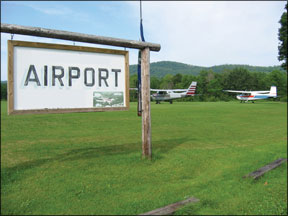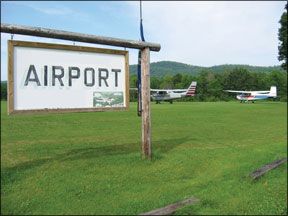Hanging out for some hangar flying with some fellow pilots recently, the lies swapped were covering the spectrum, from weather dodging and electrical-system failures in IMC to cautionary tales circulated about other aviators flights with questionable fuel. But one of our little gang spent most of the session distracted from these obviously important proceedings, preparing for a flight the following morning. A relatively seasoned pilot, he largely zoned out of the session, looking at en route charts, collating his paperwork and notes, and closing out his preparations 288 with a phone call to the destination airport-one hed never before visited. A fairly new pilot of about the same chronological age, but with a far-thinner logbook, offhandedly and inadvertently revealed an approach to planning that drew snorts of disbelief from the veterans, a tough room filled mostly with pilots who flew professionally. “You called the airport?” our middle-aged newbie taunted after the phone call ended. “Airport directories are online; Internet sites are available, along with those new sites with video-and you call?!?” Then came the big mistake. He produced his latest play-pretty, offering it up as the solution to the old pilots needs. “Heck, my handheld GPS has the entire airport directory…whaddaya want to know?” The deadpan response set the room rippling with laughter: “Well,” the veteran began, “Ive never been to this airport before and its a sod strip, so ask your little box whether the runway will still be soggy tomorrow…your handheld does know it stormed there today, right?” A silent hangar waited for the response and it came with less hubris and more humility: “No…but I can probably find out on my iPhone…if I could get the Internet in here.” The crowds second round of laughter dissolved the rookies hubris, and a forgiving crowd devolved back to its commiserating. But not even our embarrassed fledgling missed the message about the importance of preparation for first-time visits. Too Much Information? The temptation to load and launch is often enormous. You know, just fire up the GPS-doesnt much matter whose or what kind-plug in the point of origin, the destination, hit direct and go. Airport info in database form gives us access to the basics, probably even a graphic showing runway layout. Elevation, runway length and orientation, info on other elements, has grown increasingly available and sophisticated on handheld and panel-mounted navigators of all price ranges. The AOPA Airports Directory is often just a couple of button pushes away on a variety of electronic devices. Smart phones can pull up Internet sites laden with textual and graphical data, almost as quickly as reading this sentence. Meanwhile, few information sources are more comprehensive than the approach plate-providing the airport has an instrument approach and the pilot carries them; most VFR pilots of my acquaintance dont. So, with all these information sources, why do we still hear of pilots who err their way into an unhappy arrival because they failed to properly inform themselves of airport info? Some feel its the aura of the electronics-that sense that all questions can answered with a button push or mouse click. Others, perhaps more accurately, believe that aviation always has-and always will have-a percentage of pilots for whom the importance of pre-departure preparation is always casual and just not a big deal. The “I know what Im doing; Ive done this before” type of pilot. Instead, the proliferation of electronic resources and printed material makes it even harder to place that one last call to know the latest. Remember: No database is 100 percent up-to-date 100 percent of the time. Patterns And Obstructions It takes little imagination to identify the problems possible from arriving under-informed in an unfamiliar airports traffic area. You could easily enter the left downwind only to learn that the airport uses a reciprocating pattern-its always on the same side of the airport, the direction changing from left to right pattern, depending on the winds. So, while you watch for others on a left downwind, you nearly T-bone an airplane on the opposite side flying a right downwind. Or you enter on that left downwind and on the base-to-final turn come spinner-to-spinner with the airplane flying the appropriate, right-hand pattern. Maybe you launch with an old plate, an expired database or a page out of a pilots or airports guide and Flight Service mentions nothing new or different. The airports CTAF might have changed; the Unicom radio may be on the blink. Stranger things occur. The least-likely bad-news scenario seems to be the one in which the airport moves-without leaving a forwarding address-or changes elevation unexpectedly. Practically everything else is fair game. So what more does a pilot need to know? The devil can be in the details. Is the threshold displaced and, if so, why, at which end and by how much? This data should be published, but not all sources will make it apparent-particularly if its temporary. Remember-a lot of portable GPS units dont get updated every 28 days, and some get their data refreshed barely once a year. Want to trust your life to stale info? And other things can pop up on short notice-as within the timeframe of a flight. Are there any temporary issues such as an unlighted crane or workers mowing the grass between the runway and taxiway? Ground Clutter No, were not talking about the point on the chart or GPS map-thats the easy, obvious info. But where in relation to the city? If the airport sits inside a busy urban area, what help is there for getting your eyeballs on it? Heading to a towered airport like Addison, Alliance or Love Field inside the Dallas Metroplex is no place to be stumbling around at an ATC-commanded low altitude staring at the moving map hoping to actually see the airport before the tower sends you around again because you failed to report “airport in sight.” At night, none of these fields jumps out of the background light pollution until youre nearly aligned with the centerlines of their runways. During the day, they arent any easier to find. Its your job to fly the airplane and know where you are and where youre going. So, do you really want to be the dummy who stumbles through the airspace straining to find the field? With a little prep, you should notice the relative relationship of Addison to DFW, LUV and a prominent roadway-and knowing that relative position can help when its time to get your eyes off the moving map or CDI and out the windshield. And lest you think were picking on the DFW Bravo, the same issues apply in St. Louis and Kansas City, Chicago, L.A., Orlando and Tampa-big time there, folks-and any other Bravo that pops to mind. And see the sidebar on the opposite page for the granddaddy of them all. Runway Issues Some pieces of airport info can be more subtle but just as important to safely using a runway for the first time-and every time thereafter. Runway slope impacts landing performance, to the better if its uphill for you-and even that can change your sight picture and bring an unhappy arrival, if you dont know. If downhill, the whammy can double-a runway sloping away can alter your view on approach and affect your overall landing. You might float in ground effect farther, and braking distance certainly will be greater. And if the runway is wet, snow-covered or icy, well, now youre looking at a significant issue when landing downslope. Many smaller-airport runways are not flat, with a hump at one end or in the middle. Youll lose sight of the opposite end before you touch own-worth noting in case theres other traffic down there-especially if the wind is light and someone is waiting to enter the movement area or depart in the opposite direction. If the runway dips, well, the first part of the landing is downslope in both directions. How about roads? Some airports in more-rural settings have busy roads fewer than 100 feet from their physical threshold. Typically, the threshold is displaced to compensate. But being unfamiliar and a bit low on final could hide the road until that 12-foot-tall farm truck makes its appearance. Who wouldnt want to know this stuff? Parallel or Back Taxi? One little tidbit often lost in the noise of finding the airport and negotiating the traffic pattern is whether the airport comes with a full-length parallel taxiway, are back-taxi procedures in place, or is there some combination, depending on the runway in use? After landing at a favorite grass strip a few years ago-a strip with a hump in the middle-and after announcing my back-taxi intentions, it was my good luck to spot a NORDO airplane disappear below the hump on final. While powering my plane quickly toward the side of the strip, the little J-3 Cub popped over the hump on rollout, the tail just touching the sod. That pilot, a first-time visitor to the strip, was thrown off his usual approach by the steep downhill slope of the arrival end and, in his focus on the more-challenging-than-expected runway end, he never noticed us before dropping below the hump and out of sight. You need to know the airport drill, and not all of the info is necessarily in a database. At this strip, the owners wisely established a house rule about taxiing along the west edge of the 200-foot-wide strip and landing on the east side. But youd need to call to learn this. Local Issues How about local challenges that may not show up in an info database or a briefing? My personal bugaboos are twofold. First is at Westport Airport in southwest Wichita; the 2520-foot Runway 17 sports a threshold displaced south by 400 feet due to a large set of utility wires 21 feet off the ground and just north about 85 feet. Out-of-town arrivals regularly express some surprise and consternation at turning final with the threshold right where they want it in their field or view-only to arrest their descent until clearing those wires. Then they realize theyre looking at “only” a 2120-foot piece of pavement. My second stands about five miles west of the Clark County (Ind.) Regional Airport (JVY), my hometown. Standing tall and prominent atop a 600-foot escarpment is an antenna farm with towers nearing 2000 msl. The airport itself is down at about 470 feet msl. The math is easy. Worst of all, when eastbound into the area at night, the antenna farms clearance lights-there are about seven structures of varying height-blend into the background lights of houses and traffic signals and vehicular tail lights…until youre low enough to hit the highest. If youre coming in from the west and working with ATC, the Tracon generally queries pilots on their awareness of those towers; and the ILS 18 approach into JVY from the west takes you northeast before you reach the towers. But a VFR pilot, day or night, could find the towers pose a significant threat when using a GPS navigators descent profile while inbound from the west. A number of airport-information sources fail to mention these towers specifically. And this is perhaps the final word on unfamiliar airports: Even if youre the Worlds Greatest Instrument Pilot and all your en route and terminal procedure charts are up-to-date, you might never know about the towers when approaching VFR from the west on a hazy night. The lesson here is to review a VFR chart-preferably a sectional, but other resources may suffice-and look for such obstacles. Other terrain features-mountain ridges and lakes come to mind-can pose significant issues, also. The bottom line? Forewarned is forearmed. It pays to pick up the phone. Dave Higdon is a professional aviation writer/photographer and sometime passenger with several thousand hours of flight time. Hes never, ever popped open a storm window at 13,000 feet over New Mexico to take a picture without first alerting his pilot.




